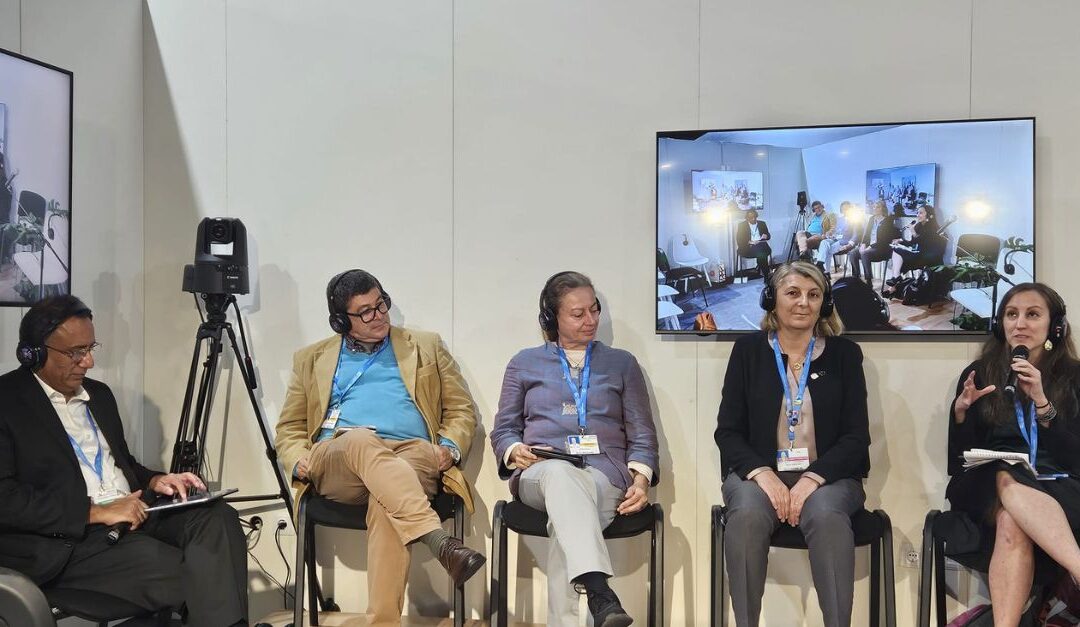We are delighted to share this blog post from Christopher Roy, Climate Change Programme Officer at the International Union for Conservation of Nature (IUCN).
As a technical advisor to ReSea — an innovative project jointly implemented by Mission inclusion and IUCN — Christopher brings valuable insights from the recent UN Climate Change Conference (COP29).
The 29th UN Climate Change Conference (COP29) provided a crucial platform to explore the intersections of science, finance, and community-led action in safeguarding marine ecosystems amidst the escalating climate crisis. Within this context, a standout panel discussion shone a spotlight on Regenerative Seascapes – an innovative approach to ocean conservation that bridges science, policy, and community engagement across regions.
This dynamic event gathered global experts and practitioners to discuss actionable solutions for restoring marine ecosystems while addressing the urgent need for equitable climate finance in the Global South.
The State of Marine Ecosystems: Insights from Science
IPCC AR6 Lead Author, Dr. Simon Donner, set the stage with sobering insights into the state of marine ecosystems and the services they provide. He highlighted the vulnerabilities of coastal and marine environments under future climate scenarios, and the viability of different climate solutions under such scenarios. From mangroves buffering against storms to coral reefs supporting fisheries, these ecosystems are lifelines for millions but are increasingly under threat.
Dr. Donner underscored a key message: without robust, data-backed adaptation strategies, the resilience of these ecosystems and their dependent communities remains precarious.
Financing Climate Action: The Global and Regional Context
The event unfolded against the backdrop of critical negotiations on the New Collective Quantified Goal – the key topic of COP29 (also known as ‘the finance COP’). Ulrike Krauss contextualised the urgent financial needs for delivering Nature-based Solutions for Adaptation, using examples like the Caribbean Biodiversity Fund’s EbA financing to illustrate challenges and opportunities for accessing climate finance at regional, national, and sub-national levels.
Torsten Thiele, expert in sustainable blue finance with ORRAA, emphasised the importance of linking corporate value chains to Nature-based Solutions (NbS) projects. He called for an integrated finance approach, highlighting upcoming opportunities like the UN Ocean Conference in 2025 to advance global commitments to marine conservation.
ReSea: A Model for Regional Collaboration
The ReSea project emerged as a flagship initiative demonstrating the potential of Gender-responsive Nature-based Solutions for Adaptation in marine and coastal ecosystems, as showcased by Genevieve Morency of Mission inclusion. Spanning five countries in the Western Indian Ocean – Comoros, Kenya, Madagascar, Mozambique, and Tanzania – ReSea seeks to foster a network of interconnected, regenerative seascapes.
Genevieve, a lead representative for the project, emphasised the critical role of partnerships with local feminist organisations to ensure gender-responsive outcomes. She presented stark disparities in the climate vulnerabilities faced by coastal communities, particularly women, and highlighted how co-creation and co-implementation are pivotal to the success of community-led solutions.
Innovative Tools and Approaches
Technological advancements and scientific tools were central to the panel discussions.
Prof. Cécile Sabourault introduced the potential of environmental DNA (eDNA) as a cutting-edge monitoring tool, enabling managers to assess the effectiveness of Marine Protected Areas (MPAs) with precision. She also stressed the importance of governance systems that bring diverse stakeholders – scientists, policymakers, and communities – to the table for collaborative decision-making.
Dr. Luis Pocasangre, drawing on his experience as a former grantee of the Caribbean Biodiversity Fund, highlighted the risks to seascapes, such as fertilizer pollution impacting mangrove ecosystems. He called for enhanced community capacities in implementing NbS for adaptation, noting that partnerships with local communities and governments are critical for achieving impact at scale.
Key Takeaways for Regenerative Seascapes
The panel emphasised collaboration, community empowerment, and innovation as key to advancing regenerative seascapes. Prof. Cécile called for data sharing to strengthen cross-regional efforts, while Genevieve highlighted the central role of local communities in achieving lasting success. Ulrike Krauss urged the integration of Nature-based Solutions into private sector and government financing, and Dr. Luis stressed the importance of applying lessons learned to improve future projects. These insights offer a clear path for regenerating marine ecosystems and building resilience to climate change.
Looking Ahead
The panel showcased a rich tapestry of expertise, from cutting-edge science to innovative finance mechanisms, all underpinned by a shared commitment to creating resilient, regenerative seascapes. Events like these are critical for bridging gaps between regions like the Caribbean and Western Indian Ocean, fostering a global community dedicated to sustainable ocean stewardship.
As the world moves toward the next milestone — the UN Ocean Conference in 2025 — the insights from COP29 will play a vital role in shaping the future of marine conservation and the regenerative blue economy.
 The message was clear: climate resilience for our oceans and communities starts with science, collaboration, and equitable financing. Initiatives like ReSea exemplify the way forward, providing hope and a tangible roadmap for regenerating the lifelines that sustain us all.
The message was clear: climate resilience for our oceans and communities starts with science, collaboration, and equitable financing. Initiatives like ReSea exemplify the way forward, providing hope and a tangible roadmap for regenerating the lifelines that sustain us all. 

Christopher Roy
Climate Change Programme Officer,
specializing in the climate-nature nexus
International Union for Conservation of Nature



